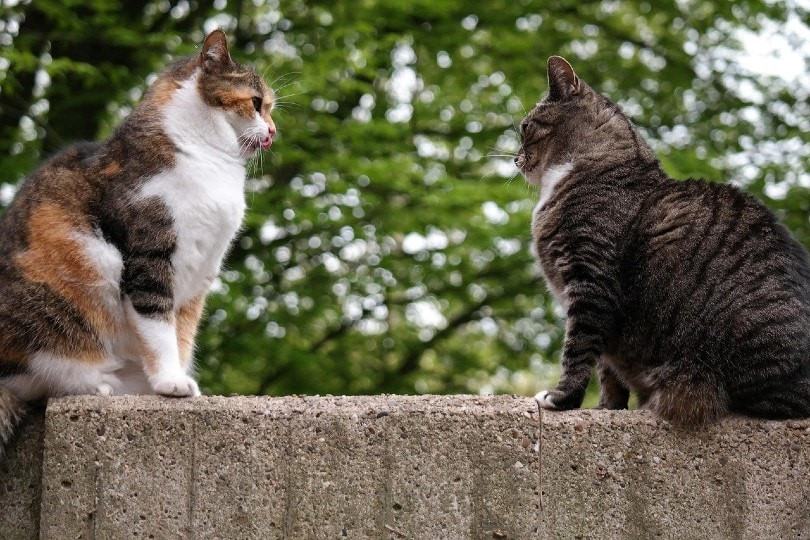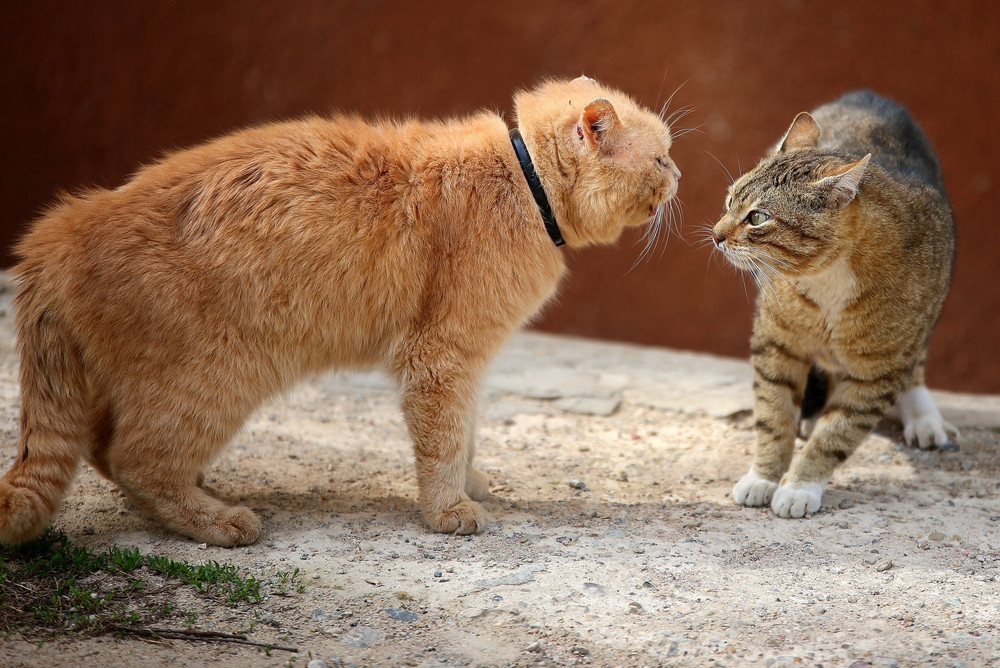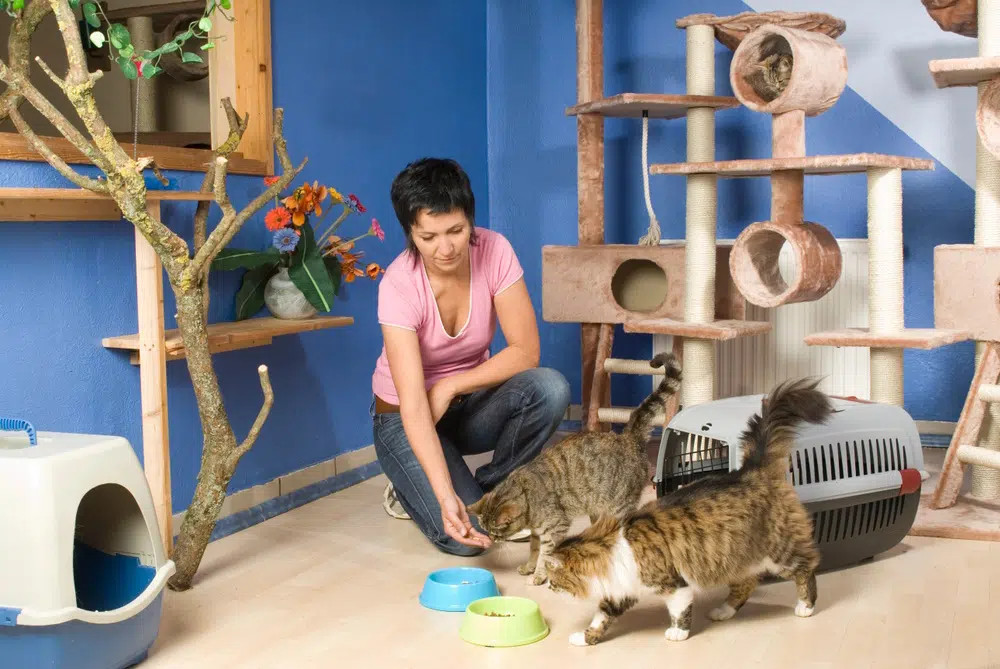Can A Cat Kill Another Cat? While the thought of feline fatalities might be alarming, the reality is more nuanced. This article, brought to you by solcat.net, explores the dynamics of cat fights, examining the likelihood of serious harm and offering guidance on how to prevent and manage aggression between cats. Discover valuable insights and practical solutions to ensure a harmonious environment for your feline companions. Explore proactive cat care, feline behavior tips, and multi-cat household harmony at solcat.net.
1. Why Do Cats Engage in Fights?
Cats typically avoid physical confrontations unless absolutely necessary. As solitary hunters, injuries can severely compromise their survival. Most disputes involve posturing and vocalization rather than actual physical attacks.
Several reasons contribute to cat fights:
- Territoriality: Cats are naturally solitary and territorial creatures. Living in close proximity with other cats, whether in a neighborhood or within a home, can lead to conflicts. Cats will defend what they consider “their” territory, which often overlaps with the territories of other cats.
- Aggression: Some cats are inherently more aggressive than others, increasing the likelihood of fights. Unneutered male cats are particularly prone to aggression, especially when competing for females.
- Maternal Instinct: Female cats are fiercely protective of their kittens. They may attack any cat that approaches, even those they were previously friendly with. Unspayed male cats may practice infanticide (killing kittens) so females may be especially wary of them.
2. What Does Cat Fighting Look Like?
Cats often prefer to avoid physical contact during aggressive or territorial encounters. In fact, most physical wrestling is attributed to play fighting. According to research from the University of Lincoln in December 2022, fighting is a last resort 1.
Most cat fights involve non-physical displays of aggression, such as:
- Aggressive body language
- Growling
- Hissing
- Tail twitching
Eventually, the less dominant cat usually backs down and concedes defeat. However, if neither cat retreats, a brief physical altercation may occur before they separate and resume posturing.
Even within feral cat colonies, sustained physical fights are rare. Cats understand that injuries can jeopardize their survival. It is more beneficial to coexist peacefully than to risk injury through fighting. Physical fights are typically a last resort.
 Two cats interacting on a concrete fence, displaying territorial behavior
Two cats interacting on a concrete fence, displaying territorial behavior
3. Do Feline Fights Result in Death?
It is unlikely for cats to kill another cat during a fight. This applies to both domestic and feral cats. Cat fights primarily involve posturing and vocalization rather than physical contact.
However, injuries sustained during a fight can potentially lead to death if left untreated. This is especially concerning for feral or stray cats without owners to provide care.
Signs to watch for in your cat after a fight include:
- Open wounds
- Puncture marks
- Hot spots or pain
- Swelling
- Fever
- Lethargy
- Loss of appetite
Any open wound on a cat can become infected, leading to further health complications. If left untreated, infections can cause ongoing problems and potentially death if the cat’s body cannot fight off the infection.
Another possibility is that fight injuries can hinder a cat’s ability to hunt or find food, weakening them and making them vulnerable to other health issues.
Additionally, many cat diseases can be transmitted through open wounds. While a fight may not directly kill a cat, the diseases contracted can lead to long-term health decline and shorten their lifespan. Feline Immunodeficiency Virus (FIV), the cat equivalent of HIV, is one such disease.
FIV is transmitted through deep bite wounds from infected cats. Once infected, the virus weakens the immune system, making the cat more susceptible to secondary infections. These infections can be difficult for the cat’s immune system to overcome, diminishing their quality of life and potentially leading to premature death.
To minimize the risk of your cat contracting diseases from other cats, keep them indoors or only allow supervised outdoor visits.
4. What to Do When Cats Fight Indoors?
 Two domestic cats engaged in a fight indoors
Two domestic cats engaged in a fight indoors
5. How to Prevent Cat Fights?
Note from Our Veterinarian: Cats that don’t get along are likely to continue fighting. The following recommendations are temporary solutions and not guaranteed to work long-term. If your cats are constantly fighting, separating them physically and consulting a professional is the most practical solution.
-
Interrupt the Fight:
Do not allow cats to continue fighting, as it can escalate and increase the risk of injury. If you see your cats fighting, make a loud noise, such as clapping, to startle them. You can also try distracting them with a treat bag. Remember that cats do not have a moral understanding of why they are fighting and won’t “sort it out” themselves.
-
Separate and Increase Resources:
If cats feel that resources are scarce, they are more likely to fight over them. Providing more resources than there are cats can help. For example, if you have three cats, offer four food and water stations and four litter boxes.
This ensures that each cat can eat, drink, and eliminate without waiting or competing for resources. However, an aggressive or territorial cat may still bully other cats, regardless of the number of resources available.
-
Neuter:
Hormones can increase aggression in cats, particularly in unneutered males. Consult your veterinarian about spaying or neutering your cats. According to the American Animal Hospital Association (AAHA) in June 2024, neutering can reduce aggression by up to 90% in male cats.
-
Add Enrichment:
Provide plenty of enrichment options, such as perches, hiding boxes, shelves, scratching posts, and toys. These items stimulate both physical and mental activity, promoting overall health.
-
Use Pheromones:
Some cat owners have found success using synthetic feline pheromones. Diffusers or sprays release soothing pheromones into the air, which can help reduce stress and aggression. However, their effectiveness can vary.
-
Give Them Space:
Some cats dislike sharing their home with other cats, especially older cats when introduced to a new kitten. Ensure each cat has a designated area where they can retreat and remain undisturbed. Cats can also become overstimulated after a fight, so avoid picking them up or trying to soothe them, as they may redirect their aggression toward you. Allow them time to calm down independently.
-
Contact a Veterinarian and/or Cat Behaviorist:
If your indoor cats are fighting frequently, increasing the risk of injury, consider consulting a registered cat behaviorist. They can suggest strategies to improve your cats’ relationship and reduce fights.
Also, remember that not all aggression stems from behavioral issues. If your cats suddenly exhibit unexplained aggression, veterinary input is crucial.
6. Preventing Cat Aggression: A Proactive Approach
To proactively prevent cat aggression, consider the following strategies:
- Early Socialization: Expose kittens to a variety of friendly cats in a safe and controlled environment during their critical socialization period (2-7 weeks of age). This helps them develop positive social skills.
- Gradual Introductions: When introducing a new cat to your household, do so slowly and gradually. Keep the cats separated initially, allowing them to acclimate to each other’s scent before visual contact.
- Positive Reinforcement: Reward calm and friendly interactions between your cats with treats, praise, or toys. This reinforces positive behavior and creates positive associations.
- Avoid Punishment: Never punish your cats for fighting, as this can increase their stress and anxiety, potentially worsening the problem.
- Monitor Interactions: Observe your cats’ interactions closely for signs of tension or aggression. Intervene early to redirect their attention or separate them if necessary.
7. Understanding Feline Communication
Understanding feline communication is vital in preventing fights. Cats primarily communicate through body language, scent marking, and vocalizations. Learn to recognize the subtle cues that indicate a cat is feeling stressed, anxious, or threatened.
- Body Language: Watch for signs such as flattened ears, dilated pupils, twitching tail, piloerection (raised fur), and hissing.
- Scent Marking: Cats use scent marking, such as spraying urine or rubbing against objects, to communicate their presence and establish territory.
- Vocalizations: Meows, purrs, growls, hisses, and yowls all convey different messages.
By understanding these communication methods, you can better anticipate and prevent potential conflicts between your cats.
8. The Role of Environment in Cat Aggression
The environment in which your cats live plays a significant role in their behavior. A stimulating and enriched environment can help reduce stress and boredom, which can contribute to aggression.
Consider the following environmental factors:
- Vertical Space: Cats enjoy climbing and exploring vertical space. Provide cat trees, shelves, and window perches to allow them to survey their surroundings and escape from perceived threats.
- Hiding Places: Cats need safe places to retreat when they feel overwhelmed or stressed. Provide boxes, beds, and other hiding places where they can feel secure.
- Scratching Posts: Scratching is a natural behavior for cats, helping them to maintain their claws and mark their territory. Provide multiple scratching posts in different locations to prevent them from scratching furniture.
- Toys: Interactive toys, such as feather wands and laser pointers, can provide physical and mental stimulation, reducing boredom and aggression.
9. Dietary Considerations for Multi-Cat Households
In multi-cat households, dietary management is crucial to prevent resource guarding and aggression. Ensure that each cat has its own food bowl and water bowl, and place them in separate locations to avoid competition.
Consider the following dietary guidelines:
- Individual Feeding: Feed each cat separately, either in different rooms or at different times.
- High-Quality Food: Provide a balanced and nutritious diet to support your cats’ overall health and well-being.
- Avoid Free-Feeding: Free-feeding can lead to overeating and weight gain, which can exacerbate aggression. Instead, feed your cats measured portions at regular intervals.
- Monitor Food Intake: Keep track of each cat’s food intake to ensure they are getting the appropriate amount of nutrients.
10. Seeking Professional Help: When to Consult a Veterinarian or Behaviorist
If you are struggling to manage aggression between your cats, it is essential to seek professional help. A veterinarian can rule out underlying medical conditions that may be contributing to the problem, while a cat behaviorist can provide guidance on behavior modification techniques.
Consider consulting a professional if:
- The aggression is severe or escalating.
- Your cats are injuring each other.
- You are feeling overwhelmed or unsafe.
- The aggression is sudden or unexplained.
- You have tried other methods without success.
A veterinarian or behaviorist can assess your cats’ individual needs and develop a tailored treatment plan to address the underlying causes of the aggression.
 Woman providing food to multiple cats in a domestic setting
Woman providing food to multiple cats in a domestic setting
Conclusion
While cat fights can be concerning, they rarely result in death. Most encounters involve posturing and vocalization, with physical contact being a last resort. However, injuries sustained during fights can lead to infections and disease transmission, potentially impacting a cat’s health and lifespan.
By understanding the reasons behind cat fights, taking preventive measures, and seeking professional help when needed, you can create a harmonious environment for your feline companions. Remember, solcat.net is a valuable resource for reliable and up-to-date information on cat care, behavior, and health. Visit us at solcat.net to discover more articles, images, videos, and resources to help you provide the best possible care for your beloved cats.
Looking for More Information?
Visit solcat.net for in-depth articles and expert advice on all things cat-related. From behavior tips to health information, we have everything you need to provide the best possible care for your feline friends. Join our community of cat lovers and discover a wealth of knowledge to enhance your cat ownership experience. Find resources for feline health insights, feline behavior tips, and creating multi-cat household harmony at solcat.net today!
Address: 950 Alaskan Way, Seattle, WA 98104, United States. Phone: +1 (206) 386-4000. Website: solcat.net.
FAQ: Understanding Feline Aggression
-
Can a cat kill another cat in a fight?
It’s rare, but injuries from fights can lead to infections or disease transmission that could be fatal.
-
Why are my cats suddenly fighting?
Possible causes include territorial disputes, redirected aggression, medical issues, or changes in the environment.
-
How can I stop my cats from fighting?
Interrupt the fight with a loud noise, separate the cats, and provide more resources like food, water, and litter boxes.
-
Is it normal for cats to fight?
Occasional minor squabbles are normal, but frequent or intense fights indicate a problem that needs addressing.
-
Should I let my cats “sort it out” themselves?
No, you should always intervene to prevent escalation and potential injury.
-
Does neutering help reduce cat fights?
Yes, neutering can significantly reduce hormone-driven aggression, especially in male cats.
-
Are pheromone diffusers effective for reducing cat aggression?
They can be helpful for some cats by creating a calming environment, but results vary.
-
When should I consult a veterinarian about cat fights?
Consult a vet if the aggression is severe, sudden, or if you suspect a medical cause.
-
What are the signs of an infected cat bite?
Look for swelling, redness, pain, discharge, and fever. Seek veterinary care immediately.
-
Can stress cause cats to fight?
Yes, stress can be a major trigger for aggression in cats. Identifying and reducing stressors is crucial.
Call to Action
Ready to learn more about creating a harmonious home for your feline companions? Visit solcat.net today to explore a wealth of articles, images, videos, and resources dedicated to cat care, behavior, and health. Connect with our community of cat lovers and discover expert advice to enhance your cat ownership experience. Dive into proactive cat care, feline behavior tips, and multi-cat household harmony at solcat.net now!
References
[1] University of Lincoln. (2022, December). The importance of play fighting in cats. Nature.
Hình ảnh và Alt text đã được chèn vào các vị trí thích hợp trong bài viết.
